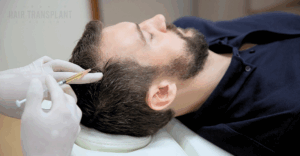Hair loss is a natural part of the aging process, but unlike gradually going gray—which can make older people look wiser or more dignified—balding can have an enormous effect on our self-esteem and the way we feel when we look in the mirror.
There are many myths around why people lose their hair. Baldness has been blamed on everything from poor circulation to the scalp, to dandruff, to vitamin deficiencies, and even from wearing a hat too often. Science has debunked all these old wives’ tales, but they still persist, even in our modern information age. Let’s take a look at why hair loss really happens, and some new options for those considering taking action to regain a fuller head of hair.
No Shave FUE creates many small hidden donor areas – Get a 2000 FUE transplant and only you will know!
Understanding Pattern Hair Loss
By the age of 50, approximately half of males and a quarter of females have experienced some form of hair loss.
Male-pattern hair loss is due to a combination of genetics and the male hormone dihydrotestosterone. This type of baldness usually begins with a receding frontal hairline that progresses until it results in a bald patch on top of the head.
Female-pattern hair loss is the result of overall thinning of hair across the entire scalp due to increased hair shedding, a reduction in hair volume in general or both. It’s very uncommon for women to bald following the male pattern, unless their bodies produce excessive androgens. Researchers are still searching to pinpoint the cause of female pattern hair loss.
Follicular Unit Extraction for Hair Restoration
For both men and women who are experiencing hair loss, there are now many new technologies to offer you options besides wearing wigs, scarves and hats to disguise your bald patches and thinning hair.
Modern hair replacement techniques use existing hair on other parts of your head or body to regrow hair and restore hair density. Follicular unit extraction, or FUE, is the most superior technique available today. Dr. Robert Jones is one of the earliest adopters of FUE in North America, and has many years of experience in this groundbreaking method.
An FUE hair transplant is a minimally invasive, outpatient procedure that is not onlyhttps://torontohairtransplant.com/hair-loss-solutions/surgical-hair-loss-solutions/fue-vs-older-methods-of-hair-transplantation/ virtually painless, but also leaves no scarring. Your hair replacement surgeon will remove hair follicles from the donor site (usually the back of the head), then transplant them one hair at a time to the thinning or bald area.
In FUE, the surgeon has complete control over the pattern and direction of each new hair placement. When fully healed, the result appears totally natural, undetectable and permanent.
The FUE process also significantly shortens recovery times. In most patients, the grafts become fully secure in about eight days after surgery, and the surgical wound in the donor area usually heals within one to two weeks.
What Is No-Shave FUE?
Traditionally, the FUE hair transplant procedure required the doctor to shave the donor zone. Patients undergoing traditional FUE treatment—especially women and men who normally wear their hair longer—may be self-conscious about going back to work or resuming normal daily activities after treatment, unless you are planning to take extended time off to let all your hair grow back to its pre-procedure length.
Small 1cm donor areas allow us to keep the FUE process hidden
However, in using a new option called no-shave FUE, the surgeon only has to trim the donor follicle hairs, while keeping all other hair at the same length. During the procedure, Dr. Jones will conceal the trimmed donor follicles among the remaining full-length hair, resulting in a completely normal, natural post-transplant appearance. Suitable for both men and women, the no-shave FUE technique makes both the process and eventual outcome of a hair transplant virtually undetectable.
Benefits of the No-Shave FUE Method:
● Patients can return immediately to work and other normal daily activities
● The technique completely conceals harvested donor sites
● Ideal for patients with scarring from previous hair transplant procedures; linear scars from the earlier method will not be visible
Who Is a Good Candidate for FUE?
For patients who have lost self-esteem due to thinning hair, FUE hair transplants can change both your life and your appearance. However, having said that, it is important to have realistic expectations going into the procedure. Before you decide to have surgery, think carefully about your expectations and discuss them with Dr. Jones.
Because FUE is such a superior method for hair restoration, 100 percent of hair loss sufferers are candidates for the FUE technique. However, in general, people who are experiencing the following issues will see the most benefit from FUE treatments:
● Male or female pattern baldness
● Scars from previous cosmetic surgery
● Missing or thinning eyebrows
● Dissatisfaction with the results of previous hair transplant procedures
● High hairlines
The FUE Process
The FUE hair transplant process relies on moving your own existing hair to balding areas to restore volume. Your hair restoration surgeon’s role is to use that existing hair as effectively and efficiently as possible to ensure the best possible results. Hair replacement candidates must have healthy hair growth elsewhere on their heads or bodies to serve as donor areas from which to harvest grafts of hair.
In determining whether FUE is the best solution for you, we will discuss factors such as:
● Number of grafts required to achieve optimal results and meet your expectations
● Cause of hair loss and family history
● Color and texture of hair
● Skin type
● Likelihood of future hair loss, based on projections
● The density of the hair within the donor area
● The number of grafts that can be harvested from the donor area
● Your overall health and lifestyle choices
Is FUE right for you? The best way to know is to meet with us for a confidential patient consultation. We will evaluate your case and discuss the results and outcomes we can expect to achieve. Contact our clinic today to schedule a complimentary consultation to discuss all your concerns about hair loss with Dr. Jones.







